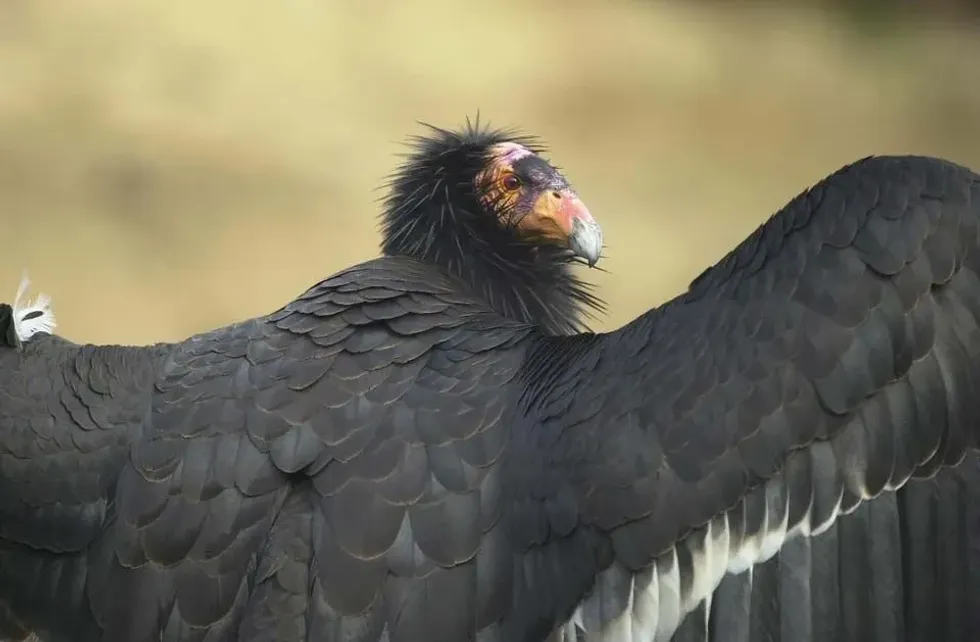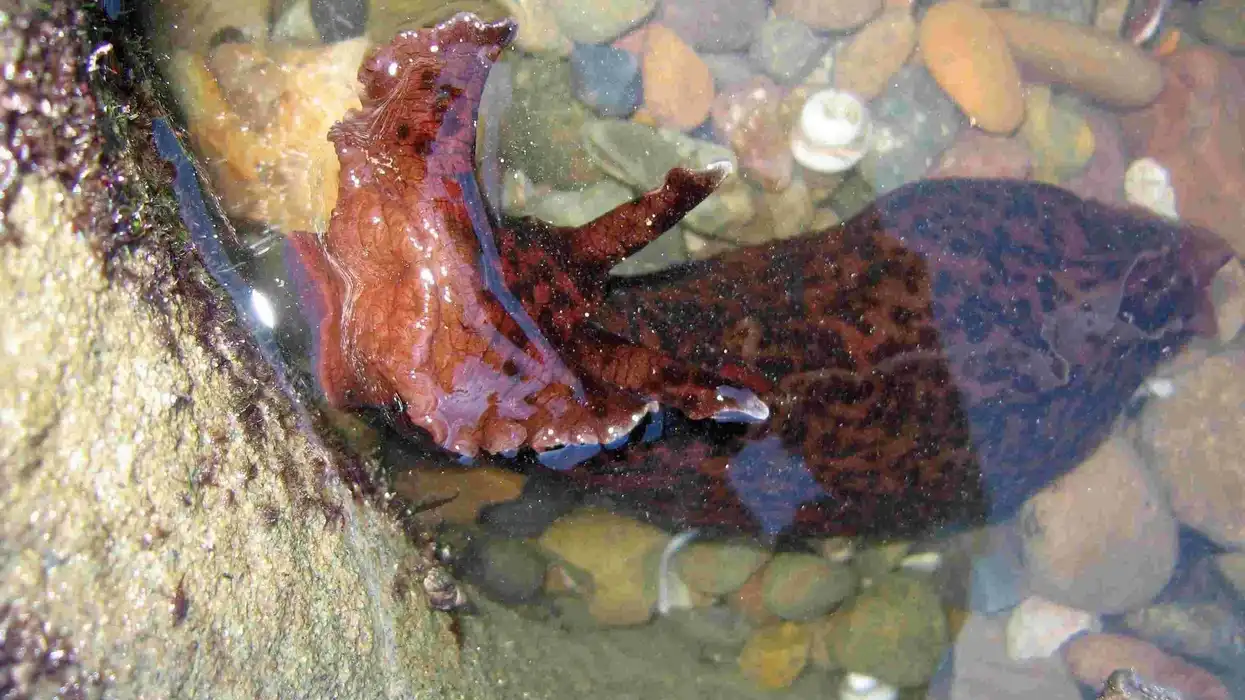The California condor (scientific name: Gymnogyps californianus) is the largest land bird from North America and is also known as a New World vulture. Condors' wings are broad and long with many feathers, which gives a fingered look to the tips of each wing.
When condors fly, their body looks bulky, their head appears small and their tail is short and broad. The captive breeding program of this species is a well-known effort to bring the animal back from the verge of extinction.
The average California condor size ranges between 44-55 in (109-140 cm). Their wings can spread from 8.2-9.5 ft (2.49-3 m) and they weigh almost 15-31 lb (7-14 kg).
They are almost double the size of turkey vultures which only grow up to 5.5 ft (1.67 m). California condors are considered different from the other birds due to their large black body and the white triangles that are found under their wings, not forgetting their orange-red bald head!
California condors lay eggs to reproduce, they mature and reproduce slowly and don't breed until they are between six and eight years old. The female lays one egg every two years and a baby condor is known as a 'chick'.
California condors nest and lay their eggs in rock crevices, caves, or in huge trees. These birds do not build a nest, they just lay their eggs directly onto the cave's floor, tree hollow, or cavity.
Sometimes they even move rocks around with their beak to improve the nesting site. They are generally afraid of human beings, but you are at risk of a California condor attack if you enter their territory, so these birds are best left alone.
They mostly prey on already dead carcasses of animals like deer, cattle, sheep, and also marine animals. Wild condors don't eat every day.
Here on our page, we have lots of California Condor bird facts that everyone will enjoy. Let's have a look at these interesting facts and if you do like these, then do read our shoebill and crowned eagle facts too!
California Condor Interesting Facts
What type of animal is a California condor?
A California condor (Gymnogyps californianus) is the largest bird in North America. It is a known scavenger.
What class of animal does a California condor belong to?
California condor birds belong to the class Aves.
How many California condors are there in the world?
At present, there are over 500 California condors flying free in the North American continent, primarily in central and southern California. This number is very low, hence why California condor sightings are very rare.
Where does a California condor live?
California condors usually reside in rocky and forested regions. California condor (Gymnogyps californianus) birds live in the forests, rocky shrubland, and oak savannas of California, Arizona, Utah, and Baja California, Mexico.
The oldest California Condor, called Topa-Topa, lives in Los Angeles Zoo and will turn 55 years old this year! He is one of the most genetically valued adult California condors as he has fathered over three dozen chicks!
This is important as the population of this massive species was decimated to just 22 birds at an earlier point in the century. Thanks to concentrated breeding and conservation efforts, the population currently is over 500 birds.
What is a California condor's habitat?
A typical California condor habitat can be found in rocky cliffs or in Californian desert land.
Who do California condors live with?
These monogamous birds live in southern California, southern Utah, and Arizona, including in the San Diego National Park, where they were bred to be reintroduced. These species are also found in Baja California. If successful with their breeding partners, condors mate for life.
How long does a California condor live?
California condors have a life span of almost 60 years.
How do they reproduce?
California condors lay eggs. These birds mature and reproduce slowly and don't breed until they are between the age of six and eight.
Females lay only one egg in two years and the male and female parents both share the responsibilities of bringing up the young. Once the eggs hatch, both parents take their turns feeding and warming them.
After five to six months, a juvenile chick practices to fly, and within two years, it is ready to hunt and forage by itself, independent from its parents!
What is their conservation status?
California condors are sadly on their way to extinction. Conservation groups in 1980 launched their efforts to bring the California condor back from the brink of extinction and, based on the knowledge that female condors lay a second or third egg if the first is removed, scientists began collecting their eggs for captive incubation.
Conservationists hope that the law protecting these birds, which came into full effect in 2019, will make a difference for the future of the California condor species.
These birds have been on the US Endangered Species list since 1967 and were classified as Near Extinction when their captive breeding program started. Lead poisoning was a major threat to condors, who were accidentally eating fragments of lead ammunition as they ate the carcasses of hunted animals.
Hunter switching to lead-free ammunition can greatly aid the California condors' recovery, and this is something that activists campaign for.
The California condor breed once included only 22 birds, but conservation measures have raised that number and the San Diego Zoo Wildlife Alliance was given permission to start the first managed propagation program for California condors.
This program involved the United States Fish and Wildlife Service, the National Audubon Society, the California Department of Fish and Game, and the Los Angeles Zoo, all working together to save these amazing birds.
California Condor Fun Facts
What do California condors look like?
These are the largest wild flying birds located in North America. They have wings that are long and broad with long individual feathers, which gives a fingered look to the tips of each wing.
When they fly, their body looks bulky, their tail is short and broad, and their head appears small. Adult coloration is reached at between six to eight years of age.
How cute are they?
These birds have a long face structure that is uplifted in the front. Their eyes, nose, and beak are very close to each other and the color of their face is a pinkish purple with red eyes and a grey beak. Some people find them cute.
How do they communicate?
California condors use a variety of hiss and snort sounds for communication, but mostly they are silent in nature.
How big is a California condor?
A California condor can be between 44-55 in (109-140 cm) big. Their wings can spread from 8.2-9.5 ft (2.49-3 m) and they weigh almost 15-31 lb (7-14 kg). They are almost double the size of turkey vultures which only grow up to 5.5 ft (1.67 m)!
How fast can a California condor fly?
A California condor's flight is at a thrashing speed of 55 mph (88 kmph). Their flight can reach 15,000 ft (4600 m) above sea level. The average California condor wingspan is 10 ft (3 m), making it the largest flying bird in North America.
How much does a California condor weigh?
The average California condor weight is 15-31 lb (7-14 kg).
What are their male and female names of the species?
The California condor has no different names for males and females.
What would you call a baby California condor?
A baby is called a California condor chick.
What do they eat?
California condors are scavenger birds. A typical California condor diet includes the leftover flesh of large mammals hunted by other carnivores (or those who died a natural death) like deer, cattle, sheep, and also marine animals. They can survive for days without a proper meal and they travel miles in search of food.
Once they eat properly, they may need to rest for around five hours. Eating these dead animals makes California conders really important, as they help to clean up their environments. Therefore, they are certainly worth saving!
All condors and vultures are carrion feeders, and they often seek out other scavengers, such as turkey vultures, to track potential food sources. At San Diego Zoo Safari Park, adult condors are fed rabbits, rats, beef, and more.
How high can they fly?
Their flight height is usually 15,000 ft (4600 m) above sea level.
Would they make a good pet?
No, they are wild birds and these birds cannot be confined to domestic living. Humans and California condors cannot live together.
Did you know...
California condors are social birds who form groups around carcasses, bathing spots, and roosts.
One of the most interesting facts about California condor birds is that these condors bathe frequently and can spend hours a day preening their feathers.
A wild condor scavenges for carrion in habitats ranging from Pacific beaches to mountain forests and meadows.
California condors nest in caves rather than building their own nests for breeding.
How dangerous is a California condor?
California condors are actually quite afraid of human beings but they can be dangerous if you enter their territory. They mostly prey on the already dead carcasses of animals like deer, cattle, sheep, and also marine animals.
Is the California condor endangered?
California Condor is critically endangered. They have been protected as an endangered species by Federal Law since 1967 and California State Law since 1971.
The population of California condors continues to be threatened by poison ingestion, mostly by lead poisoning from the bullets of hunters that are left in the carcasses they eat.
The number of condors rose thanks to a captive breeding program, and beginning in 1991, condors were reintroduced into the wild. The California condor population has grown since then thanks to these California condor conservation efforts, but still, these condors remain the rarest bird species in the wild.
Here at Kidadl, we have carefully created lots of interesting family-friendly animal facts for everyone to discover! Learn more about some other birds, including the great green macaw, or Fischer's lovebird.
You can even occupy yourself at home by drawing one on our condor coloring pages.










